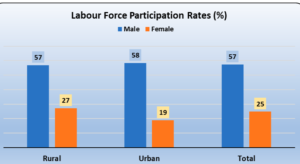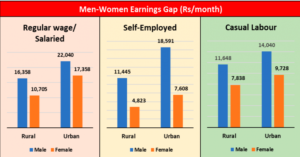
Women’s Work and Wages Continue at Abysmal Levels
Contents News/Article Date: 12th March 2023
Relating to which Act: The Indian Constitution grants the Central and state governments the powers to enact laws to protect the employees and foster a professional work environment. Based on the industry, nature of the work, number of employees in the company, location, and more, there are various legislations like the Industrial Disputes Act 1947 (ID Act), Factories Act 1948 (Factories Act), and Shops and Establishment Acts in relevant states (S&E Act).
Applicable to which State: Acts and Rules are applicable to all States
Type: News Click news report
Pertains to: Establishments and Employees in all types of Organizations running businesses for profit or nonprofit
Relevance of this news: Karma Management Global Consulting Solutions Pvt Ltd is in the business of HR Services, Payroll, Outsourcing, and Regulatory Compliances right from its inception in 2004 since then, it has brought in a lot of efficiencies and technological upgradations with experts on its roll, to ease the hassles of Payroll Processing, Temp Staffing, On-boarding, Employee Life Cycle, Statutory, Regulatory, and Payroll compliances by providing customized solutions to all its elite clients.
Now Karma Global is also fully into labour compliance for nearly 18 years and is helping both establishments and workers for the fulfillment of obligations as per the laws of the land. It has over 200 staff, both direct and indirect on its rolls and operates on Pan India basis. Recently, it has diversified into foreign shores as well, into countries like the US, UK, UAE, Canada, and South East Asia for handling payroll, outsourcing, recruitment, compliance, and governance.
Karma Global handles the obligations of all provisions contained in the labour acts and rules.. Employees are entitled to several benefits under the Employment Act, including annual paid leave, sick leave, maternity benefits, paid public holidays, etc. Employers must ensure that they meet all of the Act’s standards and that the contract conditions reflect this.
Businesses must comply with the following requirements of the Act in particular:
- Minimum wage
- Maternity benefits
- Revision of wages
- Safer work environment
- Adaptive work culture
- Issuance of employment contracts
- Social contributions
- Health care and insurance
- Holidays and annual leave
- Termination, severance pay, grievance handling, redressal
And in this instance: The share of women who are earning through work continues to remain shockingly low in India according to the latest data from the annual Periodic Labour Force Survey (PLFS) released last month. The report, compiled by the National Sample Survey Office (NSSO) under the ministry of statistics, also provides a glimpse of the unconscionable gap between the earnings of men and women.
Subject: Women’s Work and Wages continue at abysmal levels
Appended is the complete news item
The latest official labour force survey shows a 20%-50% gap between the earnings of men and women.
Source: News click
The share of women who are earning through work continues to remain shockingly low in India according to the latest data from the annual Periodic Labour Force Survey (PLFS) 2021-22 released last month. The report, compiled by the National Sample Survey Office (NSSO) under the ministry of statistics, also provides a glimpse of the unconscionable gap between the earnings of men and women.
Low Participation in Work
In rural areas, about 57% of men are in the labour force but only 27% of women. In urban areas, the situation is worse – men’s participation in the labour force is 58% while women’s is down to just 19%. Overall, this gives an average of 57% labour force participation for men and 25% for women. (See chart below) Labour force participation is the proportion of persons that are either employed or
 unemployed but seeking work.
unemployed but seeking work.
Women’s labour force participation has broadly declined in the past three decades. Seen in the larger context of persistent unemployment and very minor growth of jobs generally, this speaks of a systemic obstacle to employment growth that successive governments and their economic policies have failed to address. With the new political attention on women as voters, it is strange that one of the key deprivations that women face – lack of job opportunities – remains a neglected policy area. But then, employment itself has become a neglected area, especially under the present government.
Agriculture is Mainstay for Women, and also Services
The PLFS 2021-22 report also gives an estimated distribution of men and women workers across different types of employment. In rural areas, obviously, agriculture is by far the main source of employment with 51% of men and a whopping 76% of women involved in it. For women, this is the biggest source of gainful employment dwarfing any other work. Among men, construction (17%), trade and hotels (11%), and manufacturing (8%) are some of the other sources of jobs in rural areas. But for women, apart from agriculture, only manufacturing (8%) and construction (6%) are of any significance.
Trade and hotels/restaurants employ about 15% of the women and construction about 5%.
In urban areas, since there is no significant farming work, women’s employment drops precipitously. Among those who do find work, the biggest chunk of nearly 41% is employed in various personal services, administration, education, healthcare, etc. These are women who are working as teachers, healthcare workers, domestic servants (maids, cooks, etc), and other jobs. The manufacturing sector employs about 24% of women in urban areas, mostly in certain industries like textile/garments.
What these proportions show is that whether it is in rural or urban areas, women are concentrated more in lower-paying, perhaps contractual-type jobs, often in the informal sector. It must be underlined that the PLFS numbers show up a remarkable fact: whether men or women, the manufacturing sector is employing not more than a quarter of the workforce. This indicates the paucity of the industrialized formal sector in the economy. On the other hand, agriculture still employs over half of the men and three-quarters of the women in rural areas.
Wage/Earnings Gap
The other crucial information provided by PLFS 2021-22 is about the earnings of working people. Here the chasm between men and women is evident. This relegation of women to low-paying work or denial of equal pay for the same work is one of the factors that keep women away from gainful employment – it is just not worthwhile for women to go out for work because of the miserable wages or earnings they get.
The chart below summarises wages earned by regular or salaried workers and casual workers, and also earnings of self-employed workers (like petty shop keepers, and sellers of labour like rickshaw pullers, etc.). For regular workers, the gap between the wages of men and women is about 35% in rural areas and 21% in urban areas. For casual labourers, the chart shows daily wage rates projected to monthly rates for comparability, although in real life they get paid on daily basis with gaps in between. Here too the gap between men and women is large: about 33% in rural areas and 31% in urban areas. Mostly, their work would be the same, like carrying loads, digging, etc.
In the self-employed category – which is the one with a very large number of people working – the gap between men and women is very high. In rural areas, the difference between men’s and women’s earnings is as much as 58% while in urban areas it is 59%. In one month, a self-employed woman will earn only about Rs 5,000 in rural areas while her urban counterpart will get around Rs 7,600. This shows what the returns are for women running “enterprises” through Self-Help Groups (SHGs) and similar other programs. Pakoda-making can hardly sustain women!
Apart from patriarchal obstacles put up by families and social peers, and issues of security, low wages such as these revealed by the PLFS are also contributing to the low labour force participation rates among women. This is despite the fact that women are much more educated today than three decades ago and want to become equal productive citizens.
